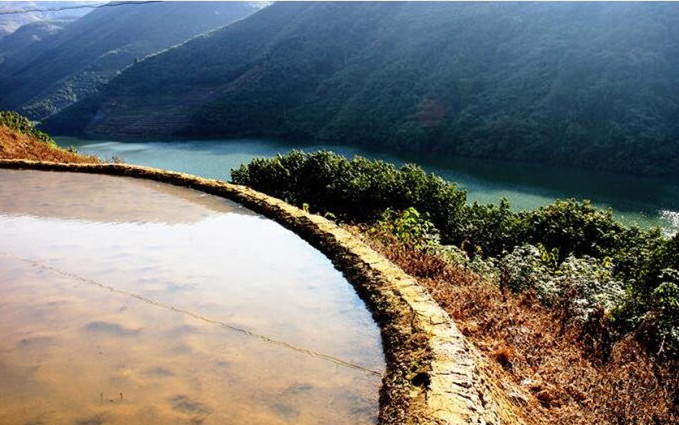
Lixianjiang River in Honghe and Puer
Chinese Name:李仙江
English Name: Lixianjiang River in Honghe and Puer
Lixian River, a tributary of the Red River, originates in the Wuliang Mountains. The river is formed by the confluence of the Baybian River and the Amu River in its upper reaches. When it enters Vietnam, it is known as the Black River and eventually flows into the Red River. It has a total length of 974 kilometers, with 480.3 kilometers within China and a drainage area of 19,366 square kilometers. As the largest tributary of the Red River, it has an annual runoff of 8.72 billion cubic meters and a maximum recorded flow of 21,000 cubic meters per second. Its flow direction is roughly parallel to the Red River.
Hydropower Development:
The river basin features a natural drop of 2,105 meters and possesses rich hydropower resources with a theoretical potential of 1,816.4 MW. The development plan, as outlined in the 1999 “Lixian River Mainstream Hydropower Planning Report,” includes seven stages of development: Yayang Mountain Hydropower Station, Shimenkan Hydropower Station, Xinpingzhai Hydropower Station, Longma Hydropower Station, Jufu Crossing Hydropower Station, Golan Beach Hydropower Station, and Tukar River Hydropower Station. Currently, the Yayang Mountain, Shimenkan, Longma, Jufu Crossing, Golan Beach, and Tukar River Hydropower Stations are operational, while the Xinpingzhai Hydropower Station is still under construction.
Scenery and Local Features:
In Luxi County and Jiangcheng County, the Lixian River is abundant in water, bordered by high mountains. The favorable climate supports dense tropical rainforests with towering trees and rich green foliage, intertwined with vines. The area is known for its large, ornamental giant peanuts with striking white trunks up to 30 meters tall, forming a tree crown resembling a giant umbrella. The fruit and taste are similar to cultivated peanuts.
The river meanders through rugged mountains, featuring steep cliffs and unique rock formations. Lush green branches and vines often hang over the water. The area is vibrant with wildlife, including wild birds and monkeys. Dragonflies skim the water, butterflies flutter around, and traditional wooden boats are occasionally seen, used by Dai women for transport or fishing. At the Tukar River border town, visitors are welcomed with local delicacies such as sour bamboo shoots cooked with fish and wild star anise dipping sauce.
As you travel 8 kilometers downstream from Tukar River, you enter Vietnam. Within 10 kilometers, the river narrows significantly, with vertical cliffs on both sides. A notable feature is a rock cave about 1 meter in diameter on the eastern bank, known as the “Ghost Cave.” Historically, the Lixian River has been a key commercial waterway, handling significant trade and transportation of goods. The Dai people once relied heavily on water transport for their livelihood.

 7 Days GolfingTour
7 Days GolfingTour
 8 Days Group Tour
8 Days Group Tour
 8 Days Yunnan Tour
8 Days Yunnan Tour
 7 Days Shangri La Hiking
7 Days Shangri La Hiking
 11 Days Yunnan Tour
11 Days Yunnan Tour
 6 Days Yuanyang Terraces
6 Days Yuanyang Terraces
 11 Days Yunnan Tour
11 Days Yunnan Tour
 8 Days South Yunnan
8 Days South Yunnan
 7 Days Tea Tour
7 Days Tea Tour
 8 Days Muslim Tour
8 Days Muslim Tour
 12 Days Self-Driving
12 Days Self-Driving
 4 Days Haba Climbing
4 Days Haba Climbing
 Tiger Leaping Gorge
Tiger Leaping Gorge
 Stone Forest
Stone Forest
 Yunnan-Tibet
Yunnan-Tibet
 Hani Rice Terraces
Hani Rice Terraces
 Kunming
Kunming
 Lijiang
Lijiang
 Shangri-la
Shangri-la
 Dali
Dali
 XishuangBanna
XishuangBanna
 Honghe
Honghe
 Kunming
Kunming
 Lijiang
Lijiang
 Shangri-la
Shangri-la
 Yuanyang Rice Terraces
Yuanyang Rice Terraces
 Nujiang
Nujiang
 XishuangBanna
XishuangBanna
 Spring City Golf
Spring City Golf
 Snow Mountain Golf
Snow Mountain Golf
 Stone Mountain Golf
Stone Mountain Golf















